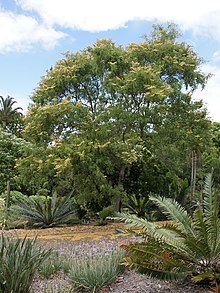
The Eastern Highlands, also known as the Manica Highlands, is a mountain range on the border of Zimbabwe and Mozambique. The Eastern Highlands extend north and south for about 300 kilometres (190 mi) through Zimbabwe's Manicaland Province and Mozambique's Manica Province.

Brachystegia spiciformis, commonly known as zebrawood, or msasa, is a medium-sized African tree having compound leaves and racemes of small fragrant green flowers. The tree is broad and has a distinctive amber and wine red colour when the young leaves sprout during spring (August–September). It grows in savanna, both open woodland and closed woodland of Southern and Eastern Africa, mostly Tanzania, Zambia, Zimbabwe, Malawi and Mozambique. The word msasa is commonly used as a proper name in African place names. The word also means 'rough plant' in Swahili. Other common names: mundu, myombo, mtondo (Tanzania), muputu (Zambia). The plant is known in the Venda language as mutsiwa, which means 'the one that is left behind'. An outlying population of Brachystegia has recently been discovered in the Soutpansberg mountains of northern South Africa. This tree is a protected species in South Africa.

Brachystegia tamarindoides, known as mu'unze and also as the mountain acacia, is a medium-sized tree with smooth grey bark, bluish-green leaves and small creamy-white flowers that produce copious amounts of pollen and nectar. It is almost always very close to upturned umbrella shaped with a partially developed flat top, making it easy to recognise in mixed woodland. In this it differs from most of the other Brachystegia species that have variable shapes. The leaves are feathery in appearance, with around 10-12 leaflets arrayed along each leaf stalk.

Miombo woodland is a tropical and subtropical grasslands, savannas, and shrublands biome located in central and southern tropical Africa. It includes three woodland savanna ecoregions characterized by the dominant presence of Brachystegia and Julbernardia species of trees, and has a range of climates ranging from humid to semi-arid, and tropical to subtropical or even temperate. The trees characteristically shed their leaves for a short period in the dry season to reduce water loss and produce a flush of new leaves just before the onset of the wet season with rich gold and red colours masking the underlying chlorophyll, reminiscent of autumn colours in the temperate zone.

Brachystegia is a genus of tree of the subfamily Detarioideae that is native to tropical Africa.
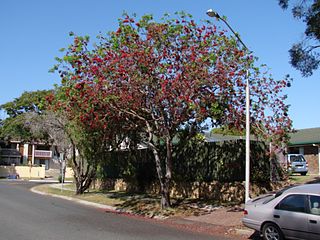
Schotia brachypetala, the weeping boer-bean, is a leguminous flowering tree in the family Fabaceae and the subfamily Detarioideae. The woodland tree is native to Africa south of the Zambezi River, where it occurs at middle altitudes. It is well-suited as shade or ornamental tree in warmer regions, and is consequently widely cultivated in gardens and parks. It is named for the copious nectar that drips from its flowers, which attracts various species of birds and insects. It is known by various other names, including tree fuchsia, African greenheart and African walnut.

The wildlife of Malawi is composed of the flora and fauna of the country. Malawi is a landlocked country in southeastern Africa, with Lake Malawi taking up about a third of the country's area. It has around 187 species of mammal, some 648 species of birds have been recorded in the country and around 500 species of fish, many of them endemic, are found in its lakes and rivers. About 20% of the country has been set aside as national parks and game and forest reserves.

Parinari curatellifolia is an evergreen tropical tree of Africa, found in various types of deciduous woodland most frequently in poorly drained areas and inland at moderate altitudes. It is also known as mmupudu, mupundu or mobola plum after the fruit, which is considered tasty and causes the tree to be spared when woodland is cleared for cultivation.
The biomes and ecoregions in the ecology of Zambia are described, listed and mapped here, following the World Wildlife Fund's classification scheme for terrestrial ecoregions, and the WWF freshwater ecoregion classification for rivers, lakes and wetlands. Zambia is in the Zambezian region of the Afrotropical biogeographic realm. Three terrestrial biomes are well represented in the country . The distribution of the biomes and ecoregions is governed mainly by the physical environment, especially climate.
Julbernardia paniculata is a medium to large tropical tree, also known as muchesa. It is widespread over the warmer parts of south tropical Africa, preferring moderately high altitudes, typically 1,000 to 1,200 metres. It is very common over its range and is the dominant woodland tree in Miombo woodland over much of central Zambia and northern Malawi.
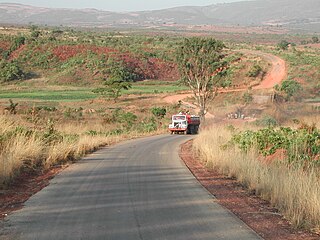
Angolan miombo woodlands cover most of central Angola and extend into the Democratic Republic of Congo. They are part of the larger miombo ecosystem that covers much of eastern and southern Africa.
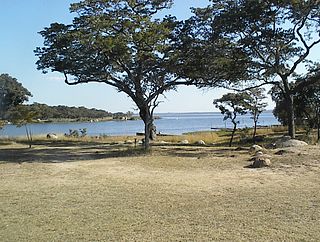
Lake Chivero Recreational Park is a protected area around Lake Chivero within the Zimbabwe Parks and Wildlife Estate.

Northern Zanzibar–Inhambane coastal forest mosaic, also known as the Northern Swahili coastal forests and woodlands, is a tropical moist broadleaf forest ecoregion of coastal East Africa. The ecoregion includes a variety of habitats, including forest, savanna and swamps.

The Zambezian and mopane woodlands is a tropical and subtropical grasslands, savannas, and shrublands ecoregion of southeastern Africa.
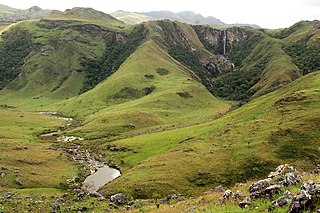
The Chimanimani Mountains are a mountain range on the border of Zimbabwe and Mozambique. The mountains are in the southern portion of the Eastern Highlands, or Manica Highlands, a belt of highlands that extend north and south along the international border, between the Zambezi and Save rivers.
Mount Chiperone is a mountain in northern Mozambique. It lies in Milange District of Zambézia Province, 40 km SSW of the town of Milange.
The Mueda Plateau, also known as the Maconde Plateau, is a plateau in Cabo Delgado Province of northeastern Mozambique.
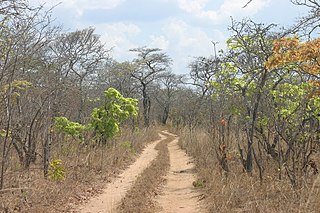
The Southern miombo woodlands is a tropical grasslands and woodlands ecoregion extending across portions of Malawi, Mozambique, Zambia, and Zimbabwe.
The Zambezian region is a large biogeographical region in Africa. The Zambezian region includes woodlands, savannas, grasslands, and thickets, extending from east to west in a broad belt across the continent. The Zambezian region lies south of the rainforests of the Guineo-Congolian region. The Zambezian region is bounded by deserts and xeric shrublands on the southwest, the Highveld grasslands of South Africa to the south, and the subtropical Maputaland forests on the southeast.

The dry miombo woodlands is an ecoregion in Africa. It has an area of 1,185,632 square kilometres (457,775 sq mi), covering portions of Tanzania, Mozambique, Malawi, Zambia, Zimbabwe, and Angola.
